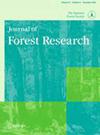Soil erosion decreases soil microbial respiration in Japanese beech forests with understory vegetation lost by deer
IF 1.1
4区 农林科学
Q3 FORESTRY
引用次数: 0
Abstract
ABSTRACT Increases in the number of wild herbivores resulted in understory degradation because of their overgrazing in forest ecosystems. Deer overgrazing has occurred soil erosion in Japanese beech forests where dwarf bamboo used to be densely covered. Soil erosion can result in a decrease in soil carbon and nutrient contents, causing the soil microbial respiration in such forest ecosystems to be degraded. The objective of this study was to clarify the effects of soil erosion, which sporadically occurs within the forests, on soil properties and microbial activity. Soil erosion indices, such as the maximum height of exposed roots from the soil surface (MAXH), tree and soil properties, microbial basal and substrate-induced respiration, were measured under the canopy of 16 beech trees in each of three deciduous broadleaved forests on southern Kyushu Island, Japan. Soil properties such as the humus mass and the organic matter contents of soil and humus decreased with MAXH. Basal and substrate-induced respiration decreased with increases in MAXH. Soil properties associated with organic matter increased with basal and substrate-induced respiration. These results suggest that soil surface layers that were rich in organic matter ran off because of soil erosion, resulting in the degradation of soil microbial activity. This study suggests that increases in wild herbivore populations degrade soil ecosystem functioning owing to the soil erosion induced by understory disappearance.土壤侵蚀降低了日本山毛榉林下植被因鹿而消失的土壤微生物呼吸
本文章由计算机程序翻译,如有差异,请以英文原文为准。
求助全文
约1分钟内获得全文
求助全文
来源期刊

Journal of Forest Research
农林科学-林学
CiteScore
3.00
自引率
6.70%
发文量
62
审稿时长
3 months
期刊介绍:
Journal of Forest Research publishes original articles, reviews, and short communications. It covers all aspects of forest research, both basic and applied, with the aim of encouraging international communication between scientists in different fields who share a common interest in forest science.
 求助内容:
求助内容: 应助结果提醒方式:
应助结果提醒方式:


